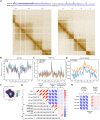This is a preprint.
Genome-wide distribution of 5-hydroxymethyluracil and chromatin accessibility in the Breviolum minutum genome
- PMID: 37781619
- PMCID: PMC10541103
- DOI: 10.1101/2023.09.18.558303
Genome-wide distribution of 5-hydroxymethyluracil and chromatin accessibility in the Breviolum minutum genome
Update in
-
Genome-wide distribution of 5-hydroxymethyluracil and chromatin accessibility in the Breviolum minutum genome.Genome Biol. 2024 May 6;25(1):115. doi: 10.1186/s13059-024-03261-3. Genome Biol. 2024. PMID: 38711126 Free PMC article.
Abstract
In dinoflagellates, a unique and extremely divergent genomic and nuclear organization has evolved. The highly unusual features of dinoflagellate nuclei and genomes include permanently condensed liquid crystalline chromosomes, primarily packaged by proteins other than histones, genes organized in very long unidirectional gene arrays, a general absence of transcriptional regulation, high abundance of the otherwise very rare DNA modification 5-hydroxymethyluracil (5-hmU), and many others. While most of these fascinating properties were originally identified in the 1970s and 1980s, they have not yet been investigated using modern genomic tools. In this work, we address some of the outstanding questions regarding dinoflagellate genome organization by mapping the genome-wide distribution of 5-hmU (using both immunoprecipitation-based and basepair-resolution chemical mapping approaches) and of chromatin accessibility in the genome of the Symbiodiniaceae dinoflagellate Breviolum minutum. We find that the 5-hmU modification is preferentially enriched over certain classes of repetitive elements, often coincides with the boundaries between gene arrays, and is generally correlated with decreased chromatin accessibility, the latter otherwise being largely uniform along the genome. We discuss the potential roles of 5-hmU in the functional organization of dinoflagellate genomes and its relationship to the transcriptional landscape of gene arrays.
Conflict of interest statement
Competing Interests The authors declare no competing interests.
Figures



Similar articles
-
Genome-wide distribution of 5-hydroxymethyluracil and chromatin accessibility in the Breviolum minutum genome.Genome Biol. 2024 May 6;25(1):115. doi: 10.1186/s13059-024-03261-3. Genome Biol. 2024. PMID: 38711126 Free PMC article.
-
Transcription-dependent domain-scale three-dimensional genome organization in the dinoflagellate Breviolum minutum.Nat Genet. 2021 May;53(5):613-617. doi: 10.1038/s41588-021-00848-5. Epub 2021 Apr 29. Nat Genet. 2021. PMID: 33927397 Free PMC article.
-
Organization of the genome and gene expression in a nuclear environment lacking histones and nucleosomes: the amazing dinoflagellates.Eur J Cell Biol. 2005 Mar;84(2-3):137-49. doi: 10.1016/j.ejcb.2005.01.002. Eur J Cell Biol. 2005. PMID: 15819396 Review.
-
Loss of nucleosomal DNA condensation coincides with appearance of a novel nuclear protein in dinoflagellates.Curr Biol. 2012 Dec 18;22(24):2303-12. doi: 10.1016/j.cub.2012.10.036. Epub 2012 Nov 15. Curr Biol. 2012. PMID: 23159597
-
An overview of transcription in dinoflagellates.Gene. 2022 Jun 30;829:146505. doi: 10.1016/j.gene.2022.146505. Epub 2022 Apr 18. Gene. 2022. PMID: 35447242 Review.
References
-
- Rizzo PJ. 1991. The enigma of the dinoflagellate chromosome. J Protozool 38(3):246–52.
-
- Wargo MJ, Rizzo PJ. 2001. Exception to eukaryotic rules. Science 294:2477. - PubMed
-
- Rizzo PJ. 2003. Those amazing dinoflagellate chromosomes. Cell Res 13:215–217. - PubMed
-
- Hackett JD, Anderson DM, Erdner DL, Bhattacharya D. 2004. Dinoflagellates: a remarkable evolutionary experiment. Am J Bot 91:1523–1534. - PubMed
-
- Lin S. 2011. Genomic understanding of dinoflagellates. Res Microbiol 162(6):551–569. - PubMed
Publication types
Grants and funding
LinkOut - more resources
Full Text Sources
Molecular Biology Databases
